Vehicle body slip angle and tire slip angles are a key concept in understanding vehicle dynamics. Each angle measures the angle between the direction the vehicle or its tires are heading and the actual direction they’re moving in.
Ever noticed how sometimes where you’re looking isn’t exactly where you’re heading? That’s the idea here. When driving straight, the direction you’re facing and moving in match. But when you turn, these directions change, creating what we call slip angles. These angles can differ not just between the front and rear tires but also from left to right.
The vehicle slip angle gives us a snapshot of how the vehicle is moving overall. Meanwhile, the tire slip angle is all about the force the tires generate to help you turn or corner. Understanding the difference in slip angles between the front and rear tires can tell us a lot about the vehicle’s behavior—whether it tends to understeer or oversteer.
This post will break down these concepts using a simple bicycle model to explain how body slip angle affects the slip angles of both the front and rear tires.
Table of Contents
What is Vehicle Body Slip Angle?
Imagine your vehicle’s center of gravity—the central point it would balance on if it could. The body slip angle is the difference between this point’s direction of movement and the direction the front of your vehicle is pointing. This angle changes, especially when you’re turning. We’ll call this angle \(\beta\) in our discussion.
When a vehicle turns at a constant speed (magnitude of velocity), its lateral (side-to-side) acceleration is described by two things: the body slip angle \(\beta\) and yaw rate \(\gamma\) (how fast it’s turning).
For more details, please refer to the following article.
https://www.racetechlab.com/basics-of-cornering/
What About Tire Slip Angles?
For anything to move in a circle (like your car when turning), it needs a force pulling it towards the center—this is centripetal force.
For more details, please refer to the following article.
https://www.racetechlab.com/lateral-g-forces-in-race-cars/
In vehicles, this force comes from the tires grabbing the road, creating what we call cornering force. This means the tire slip angle, which helps determine how much force the tires can generate to keep you turning, is crucial.
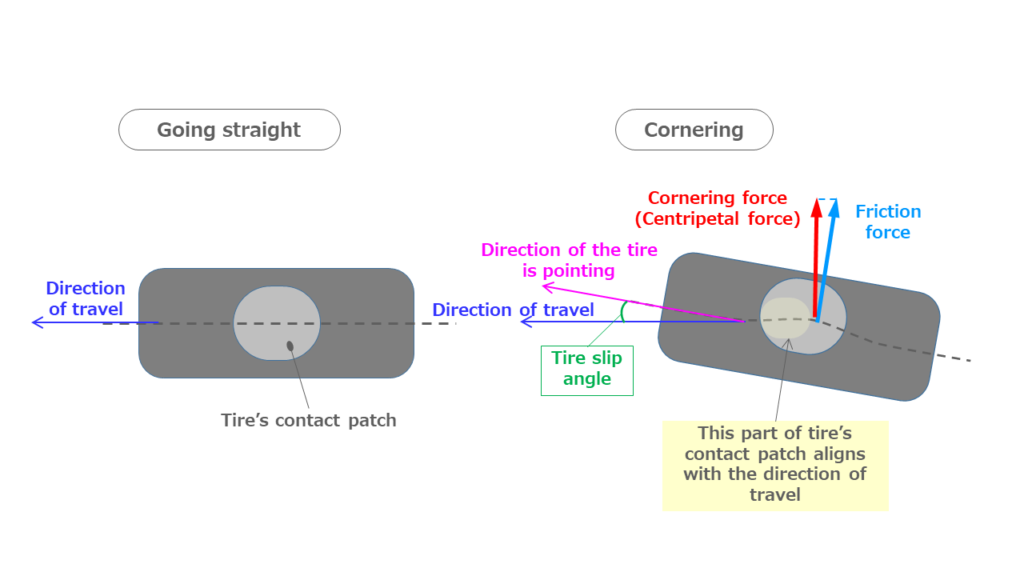
This figure illustrates a tire in motion from a bottom-up view. When you turn the steering wheel, the tire gets a slip angle. Due to its friction, the road surface tries to make the tire’s contact patch (the area where the tire contacts the ground) follow the direction the tire is travelling. This causes the road to push the tire sideways. This pushing force is the source of cornering force.
Consequently, the tire slip angle becomes a critical factor in determining how much cornering force is produced.
Explaining Through a Bicycle Model
In a previous section titled “What is Body Slip Angle?” we showed that the basic vehicle motion can be described by body slip angle \(\beta\) and yaw rate \(\gamma\).
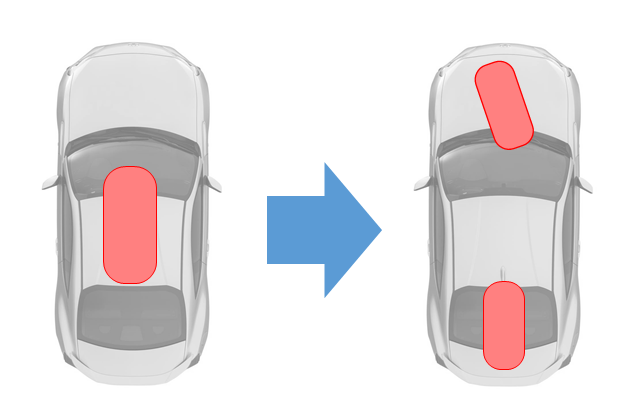
It was a very simple imaginary vehicle concept where we pretend that the tires of the vehicle are placed right at the vehicle’s center of gravity. This was to make it easier to understand. But to talk about a more realistic vehicle, we moved on to a model that has two wheels, like a bicycle.
This means we took a real vehicle, which has four wheels (two in the front and two in the back), and imagined it as just having two wheels by combining the front two into one and the back two into one.
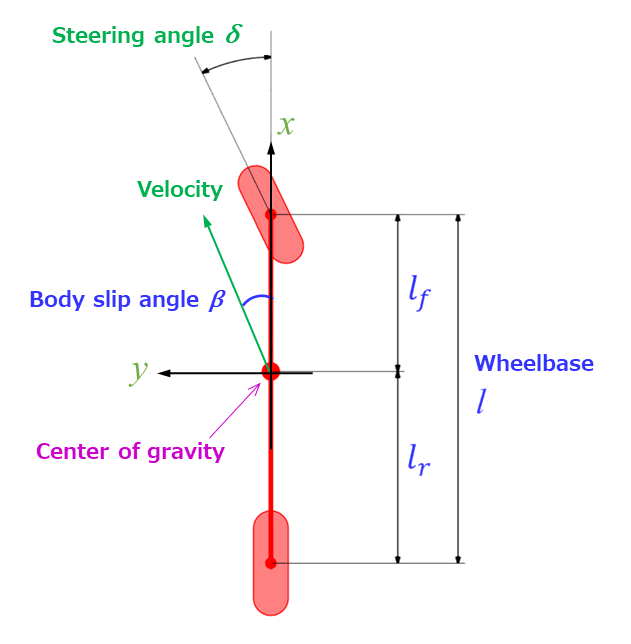
This two-wheel model or “bicycle model” helps us explore the idea of tire slip angles for both the front and rear tires.
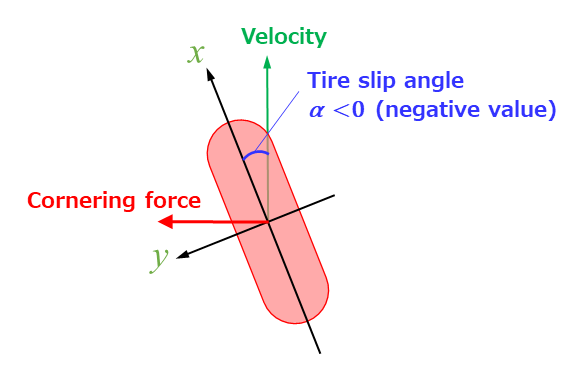
The tire slip angle \(\alpha\) is the direction of velocity as viewed from the tire rotation plane (x-axis). Counterclockwise is positive.
Cornering force occurs on the opposite side of the tire from the direction of travel across the x-axis.
Geometric relationship between body and tire slip angle
Since the direction of velocity differs for each part of the vehicle body, the body slip angle also differs for the center of gravity, the front axle, and the rear axle.
In the figure below, the positive and negative signs of the body slip angle \(\beta\) at the vehicle center of gravity, the body slip angle at the front axle \(\beta_f\), and the body slip angle at the rear axle \(\beta_r\) are as follows:
\[\beta \gt 0, \beta_f \gt 0, \beta_r \lt 0\]
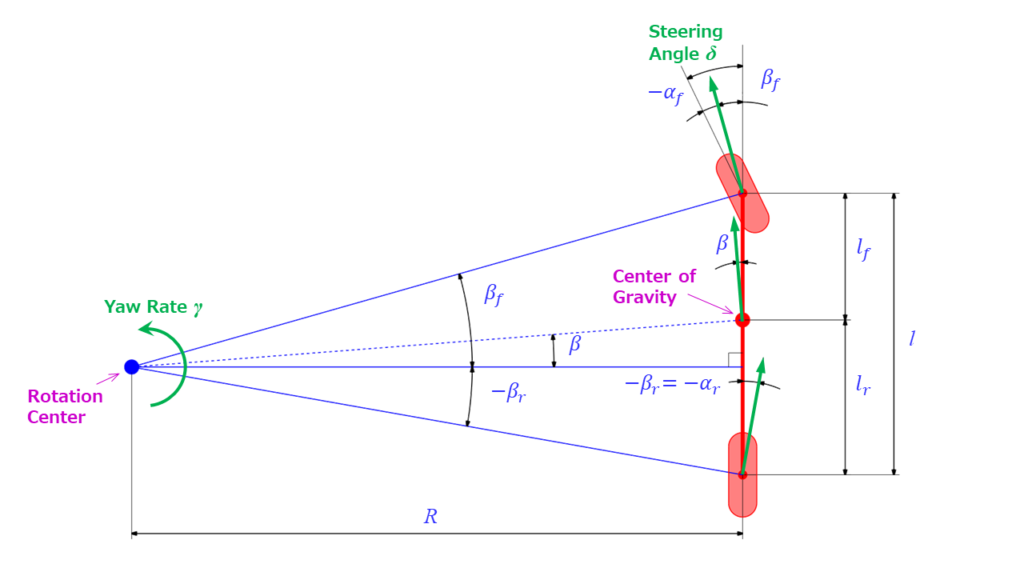
The above figure is drawn so that the front and rear tire slip angles are the same (\(\alpha_f = \alpha_r\)).
The rear tire slip angle \(\alpha_r\) is negative in this figure because it is equal to the vehicle body slip angle at the rear axle \(\beta_r\).
For the front tire slip angle \(\alpha_f\) to be negative as well, the driver must turn the steering wheel so that the tire steering angle \(\delta\) is:
\[\delta \gt \beta_f\].
If the tire slip angle is negative, cornering force is generated in the direction of the center of the turn in this figure. This cornering force becomes a centripetal force and allows the vehicle to turn.
Due to the geometric relationship in this figure, the following equation holds:

Therefore,

How is the rotation radius obtained?
The rotation radius can be obtained from the vehicle speed and yaw rate.
The time it takes to complete one revolution around a circle of radius R can be expressed in two ways.
Since the body rotates once during one revolution of the center of gravity, we have

This means that the turning radius can be calculated from the logged data of the car if it contains yaw rate.
Conclusion
To sum up our discussion, we can figure out the front and rear tire slip angles from the vehicle body slip angle, turning radius, and steering angle. The turning radius is obtained from the vehicle speed and yaw rate.
Measuring the tire slip angle directly on the tire can be quite complicated. However, we can estimate this slip angle by observing the vehicle slip angle, vehicle speed, yaw rate, and steering angle.
An interesting point to note is that if we look at the difference between the front and rear tire slip angles, it is not even necessary to measure the vehicle body slip angle.
In fact, the difference between the front and rear tire slip angles is an indicator of steering characteristics such as understeer and oversteer. We’ll dive deeper into this topic in a future article.




